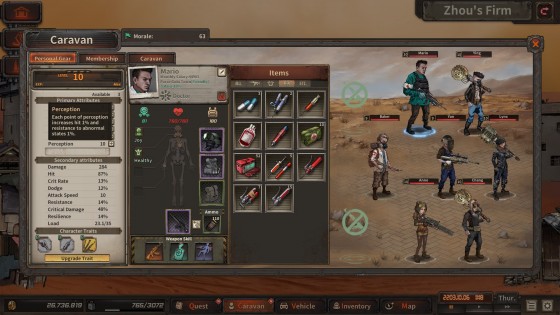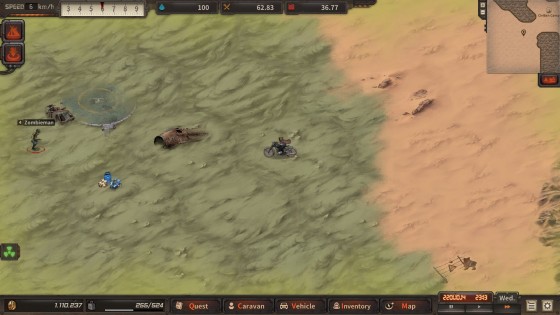Dust to the End Review

You are one of the lucky ones, having grown up in a vault following the apocalypse that savaged the Earth. Or so it seems, until one day a group of masked marauders breaks into your home, murdering and enslaving your friends and family. But wait! This is not another Fallout inspired post-apocalyptic RPG. This is Dust to the End. The twist is as you leave the vault and try to cross the seemingly endless desert without food and water, you are rescued by a small village’s caravan. And luckily enough, labour is in real shortage, especially the labour of someone who has grown up properly nourished. You become a caravan hand and leader. At its heart Dust to the End is a janky Chinese low budget indie sandbox trading simulator with RPG elements. To find your friends and family, you’ll have to make your fortune by trading with villages and building up their industries. You can also raid vaults and after “clearing out” their former inhabitants, turn them into farming plantations or mines. To be capable of all this you’ll have to be able to hire and pay a bunch of mercenaries, as well as equipping and training them with the best weapons the wasteland has to offer. Only with might and money will you be able to survive the endless desert and eventually reach your goal.
Character Building
When starting Dust to the End, most RPG players will feel right at home. First, you’ll start by designing your character. You get to choose between 2 of the game’s five character classes, namely a melee or ranged fighter, then you’ll get to assign typical RPG attributes and choose 3 combat and one noncombat perks. These are important choices which can’t be changed over the course of the game. You’ll get additional attribute points when leveling up. The other 3 classes, the merchant trader, doctor and engineer focus on non-combat perks and you can only gain these by hiring members of these classes onto your caravan from a bar. These can only be found in the world's biggest settlements. You can also upgrade your perks and this brings us to one of the faults of Dust to the End. The game has a lot of systems. Some of them like upgrading perks and taking over a bunker are barely explained. For example, the skill books you’ll need to find to upgrade your perks initially are only obtainable by slaughtering zombies in the world’s radiated zones. Later you can get these books from slot machines at bars. Another seemingly strange element of the game, is that almost all the of game’s upgraded weapons and armor are only available as rewards from slot machines and are not available in stores. Though you get your first quirk book during an early game quest in a radiated zone, this is hardly an intuitive system. Like in a typical RPG, you’ll need to manage your character’s inventory, buying and upgrading your weapon and armor, ammo, and medical supplies. You’ll also want to try to maintain your party morale by hiring mercenaries who have compatible personality traits. Injuries and illness can further deteriorate your morale, but if you’re luck enough to stop at a settlement large enough to have a pub, you can buy a round of drinks and take a break, both to recover health and raise your morale.
You'll want a good mix of combat and noncombat perks to keep your party effective in all situations.
Money Talks
The heart of Dust to the End is your trading caravan. The game’s first quest is to travel a loop between many small settlements and one city, buying whatever is locally produced, and selling it in the next community. Initially your caravan is made of two characters and their backpacks, but soon enough you get a cart. You will be able to upgrade your caravan as you go trading in carts for motorcycles, then cars, and finally huge trucks. You can also make investments in towns. First you can create your own merchant guilds and buy stock in towns, which helps generate a small regular income. In addition you can pay money and goods to develop a settlement’s industry. While this is expensive and while acquiring and transporting the needed materials is often a chore, upgraded towns produce more expensive goods, which potentially increases your profit margin. You can also acquire your own factories, which means finding a bunker, clearing it out of bandits, “hiring” workers, and building up the factory.
Bunkers are the game’s dungeons and are an interesting change of pace to travelling the wastes. Dust to the End also has a robust crafting system. While this allows you to upgrade weapons, ammunition, and armor, it also lets you make superior items. With the right materials, you’ll turn cotton to fabric, salt, water, and light leather to leather, and leather and cloth into clothing. All these tasks take energy, and the action of crafting unlocks new crafting recipes. The robust economic systems of Dust to the End, with its variety of systems, and the cycle of making money, upgrading, improving, and investing provides an addictive loop and constant motivation to make another trade run. There are always a lot of attractive options to build a bigger, better, and stronger caravan.
Bunkers produce free goods once you set them up.
Survival and Combat
Getting to the places where you buy and sell goods in a post-apocalyptic desert world, which seems more inspired by Mad Max than Fallout is no easy task. All of your caravan members need to eat and drink, and once your caravan is motorized, you’ll also need gasoline. Running out of these things in the desert is bad news, as your caravan will start losing health, or your vehicles will start falling apart. Party members heal slowly when traveling, but you can also camp (at the expense of food and water) or visit a bar to heal health more quickly. There are also various healing items, which you can use underway, but this is by far the least cost-efficient way to recover health. Vehicles will also need to be repaired regularly. Luckily when you plan out a trip between known locations on the overland map, the projected consumption of food, water, and fuel is shown. In addition to having enough resources, you’ll have to worry about sandstorms and the dangerous creatures that roam the wasteland. Sandstorms will do damage to anyone who gets caught in one. If you’re lucky enough to be next to a settlement, you can hide there until the sandstorm passes. If not you can try to wait them out in a tent (if you’ve bought one) or try to drive through them (to the other end) to get out as fast as possible.
Monsters can be broken down into various groups of gangster, hyenas, and giant mutant worms (called bugs). There are also zombies, but these are exclusively in the radiated zones. Unfortunately, you don’t encounter new enemies as the game progresses, just stronger ones. If combat were the main portion of the game, this would be unforgivable. As things stand, it is still unfortunate. The only upside is that human opponents usually drop food and water, which is good if you’ve poorly planned your trip. Bugs and hyaenas drop crafting material which you can use to upgrade weapons and armor. This means you can usually find these materials easily. You’ll need to protect yourself against enemies you can’t avoid. Combat is somewhat reminiscent of JRPG combat, starting as 2 vs. 2 affairs, and eventually growing into 6 vs. 6 battles. Each weapon has a base attack and 2 special attacks, which are fueled by action points which you get from landing normal attacks. All this is fine and good and a staple of JRPG combat. In general, if you are the same level as your enemies and have the best gear for your area, you’ll be taking down each enemy after 3-5 hits. This is fine in the small battles at the game’s beginning, as the battles are pretty fast. However, combat begins to drag out too long once you get to 4 vs. 4 or larger battles. Luckily you can do auto combat, though like in many games the results are worse than if you run the combat normally. It does let you breeze through lopsided combats which you would easily win. Luckily much weaker monsters actively try to avoid you. The point of combat seems to be to drain your party of resources, and its rare that a single nonstory battle is deadly. Also, while there is a pretty nice selection of varying ranged and melee weapons, you never unlock new attacks, and so combat only becomes more complex because of the increasing number of combatants.
Story and Exploration
There is a story and main questline in Dust to the End. You are searching for your former bunker mates who have been enslaved. You end up chasing rumors of their whereabouts across the world. The main quest usually involves gathering information in one area, completing 3 to 4 tasks in that location and then opening up a new one. Each area has new towns to discover, better equipment to buy, and stronger enemies to fight. The writing in Dust to the End is functional and understandable but feels like it was translated out of another language. That’s not all too important as the text is minimal, and quests are very straightforward. Dust to the End is not a story-oriented game. There are side quests and jobs as well, the latter being mostly kill x enemies or bring x items to x location. These are important once you open up your guild office, since by completing jobs you are rewarded with guild shares, which you can’t buy with money. With these shares you can buy market shares which give you a fixed monthly income. This fixed income help offset the ever-increasing salaries of your caravan mercenaries.
Quests break up the normal tasks of traveling and trading and push you forward, and so like most everything else in Dust to the End, they seem more mechanically and game play oriented than acts of storytelling or creative endeavors. Each time you enter a new area, you have a mostly blank map. You usually only know the location of one or two major settlements, which means you’ll have to find the others by travelling around. This makes each area interesting to explore at least initially, since you’ll want to know where settlements are so you can set up the best trade routes, and decide which settlements are worth upgrading. While exploring you’ll run into random events, side quests, and run into random stashes. These don’t change much from area to area, and once you’ve found all the major settlements, there is little point to wandering far from the most profitable trade routes. While the world of Dust to the End is consistent and nicely rendered with its artwork, new areas don’t offer up all that much that is new. If you aren’t convinced by the core gameplay loop by the time you finish the second area, don’t expect the game to give you any great arguments to continue on later.
Though the writing isn't elegant, the translation is easy enough to understand. You won't do all that much reading in any case.
Presentation
I liked both the artwork and music in Dust to the End. While this is clearly an indie game, it looks and sounds better than a lot of other indie games on the market. Especially the artwork conveys the atmosphere of the world of Dust to the End. The attention to detail of the various vehicles, laborers, and mercenaries really stands out. I find the artwork, far more than the text or the quests lifts Dust to the End out of the generic feeling post-apocalyptic world.
The attention to detail in the artwork brings the world of Dust to the End alive.
Summary
Dust to the End has a lot of elements which bother me in other games. Its grindy at times. You need ever more money to upgrade your equipment as well as your vehicles and to pay your salaries. This means running through your trade routes multiple times. Combat is also grindy and too long with far too little variety in the enemies you face. Luckily once you have established yourself in a new area, it drops off as enemies will begin to shy away from combat. How some things work in the game sometime don’t seem to scale well. For example, taking over bunkers is very profitable early on in the game, but later in the game seems hardly worth the effort. Also, some of the systems are illogical and not well explained. Still, I kept on sinking hours into Dust to the End. I liked that the game moves at my pace. I also enjoyed the myriad of different things I can do in Dust to the End. Though trading is your primary activity, upgrading your group, fighting, buying guild shares, gambling, upgrading towns, and conquering bunkers give you a lot of other things to do. Most importantly I found the central trading mechanics enjoyable. I think the game is visually appealing and love the atmosphere the art conveys.
Dust to the End reminds me the most of trading games with some RPG elements like the Port Royale series as well as the Merchant Prince series and its successor The Rise of Venice. However, it is definitely more of an RPG than any of those games are. There are a very small number of games like these, and most of the ones I have tried (in contrast to all of the aforementioned ones) aren’t particularly good. Dust to the End fills a niche where there is very little good competition, but in a very different world and in a very unique way.

Information about
Dust to the EndDeveloper: ZJOY
SP/MP: Single-player
Setting: Post-Apoc
Genre: Strategy-RPG
Combat: Turn-based
Play-time: Unknown
Voice-acting: Unknown
Regions & platforms
Internet
· Homepage
· Platform: PC
· Released: 2021-08-11
· Publisher: ZJOY
More information
Summary
Pros
- Addictive core trading loop
- A variety of activities keeps gameplay fresh
- Atmospheric, attractive artwork
- Huge world to explore
- Good pacing
Cons
- Side quests and jobs generic
- Some mechanics inadaquately explained/illogical
- Texts sometimes awkward
- Combat can get tedious
- Far too few kinds of enemies















